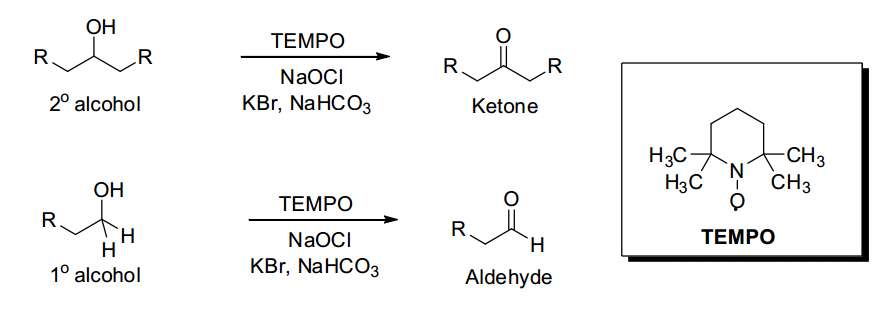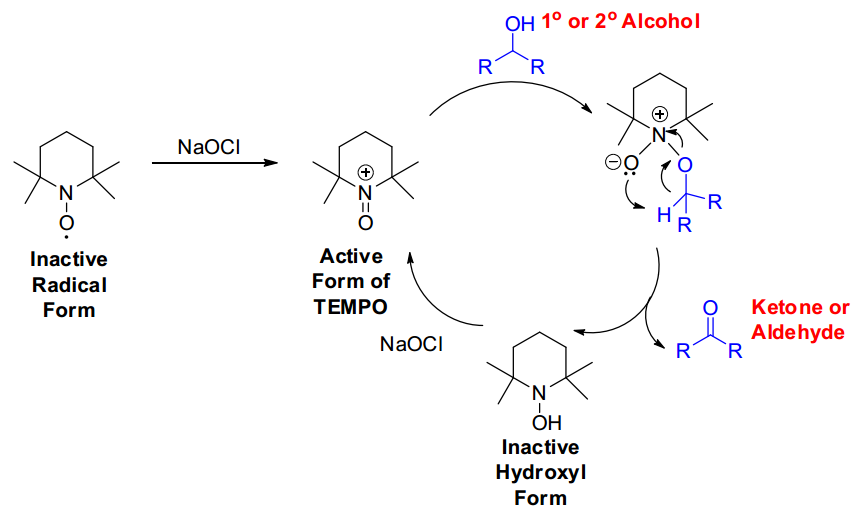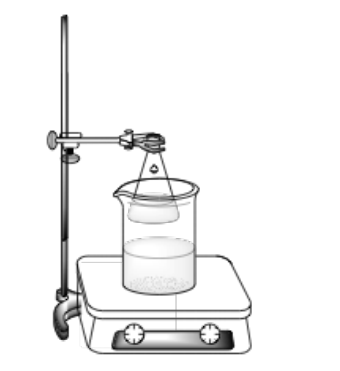Background
Alcohol oxidation to aldehydes and ketones is vital during the synthesis of organic compounds. However, bleach can only directly oxidate some alcohols to carboxylic acids, ketones, or aldehydes. The shortcoming emerges because oxidation requires displacement of OH using NaOCl during substitution reaction (Chem 242: Lab Section, 2014). Most organic molecules with an alcohol species necessitate employing a catalyst for oxidation via bleach because hydroxyl ions (OH-) dissociate poorly; thus, only minimal molecules get involved in reactions. The most utilized catalyst is (2,2,6,6-Tetramethylpiperidin-1-yl)oxyl (TEMPO), and its blend with bleach is essential in the oxidation of primary and secondary alcohols to aldehydes and ketones, respectively.

The modern research in organic chemistry has established several procedures for performing TEMPO oxidation. One such simple and practical approach to alcohol conversion into aldehydes and ketones was discovered by James Cella (Chem 242: Lab Section, 2014). This was witnessed in the 1970s when he also postulated TEMPO as a radical where the free unpaired valence electrons are contained in oxygen atoms (Chem 242: Lab Section, 2014). TEMPO is distinct from the majority of other oxygen radicals. They are very stable and are attributed to their 4-methyl groups on the lop that inhibit other molecules from dimerizing with unbonded radical electrons of oxygen. Consequently, TEMPO increases the rate of alcohol oxidation in the presence of strong oxidants such as NaOCl. TEMPO employs the following mechanism for activation to an alcohol oxidant upon reaction with other oxidants such as bleach.

The bleach-TEMPO reaction is biphasic since it contains an aqueous and organic layer. The former constitutes bleach and several salts, while the organic solvent comprises dichloromethane or tetrahydrofuran. TEMPO glides back and forth between the dual layers during a successful oxidation reaction, thereby oxidizing alcohols in the organic fraction (Chem 242: Lab Section, 2014). After that, it goes back to the aqueous portion to be oxidized by bleach. Notably, TEMPO turns into deep orange-red color to dull yellow during the reaction and ultimately fades off entirely after the end of the reaction.
Procedure
Previously prepared alcohol was dissolved in 10 ml of CH2Cl2. The mixture was then transferred to a 50 ml Erlenmeyer flask which had a magnetic stir bar. 30 mg, 10 mg, 0.70 g, and 5 ml of TEMPO, KBr, NaHCO3, and deionized water, respectively, were added to the blend in the 50 ml Erlenmeyer flask. The resulting mix was vigorously stirred using the magnetic bar. After that, 10 ml of bleach solution with a concentration of 0.72 M was added, and all the observations were recorded.
The reaction mixture in the 50 ml Erlenmeyer flask was then stirred for one hour. The biphasic composition was later transferred to the separatory funnel and separated the phases. The organic fraction phase was collected, and the aqueous portion was added back to the separatory funnel. This was followed by the addition of 5 ml of CH2Cl2 and subsequent extraction of the aqueous layer. The entire organic fractions were homogenized in a beaker and dried using one gram of sodium sulfate (Na2SO4).
A steam bath was created through heating of a water beaker on a hot plate, as shown in the beneath setup. The dried organic compound was decanted, pre-weighed, and the 50 ml Erlenmeyer flask cleaned. Upon the formation of the viscous oil, 5 ml of hexane were added to the Erlenmeyer flask and swirled. The flask was allowed to settle for five minutes, and the formed crystals were collected via vacuum filtration. The flask was resubjected to the steam bath to ensure extraction of the entire solvent. Finally, the collected crystals and oil were weighed, the melting point of the crystalline taken, and the computed experimental percent yield recorded.

Reference
Chem 242: Lab Section. (2014).